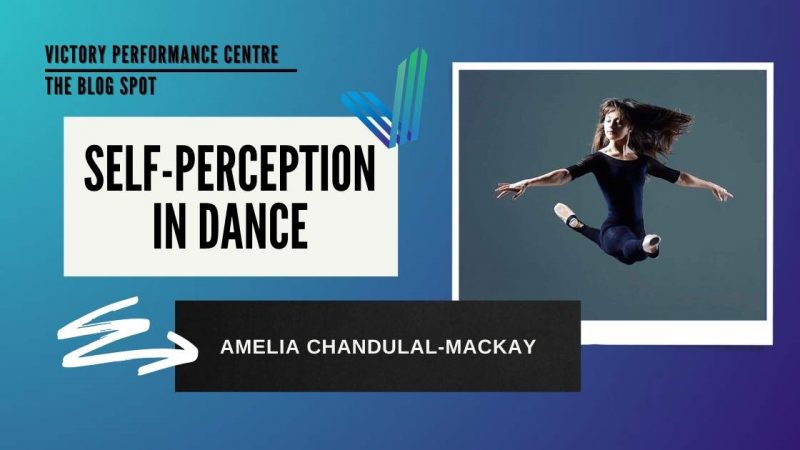THE VPC BLOG SPOT [HEALTH]

Amelia is a dancer, teacher and student at the University of Auckland, studying a double major in psychology and criminology. She has danced with Orlando Ballet, Milwaukee Ballet, Oklahoma City Ballet and was in the scholarship program at Alvin Ailey American Dance Theatre. She has taught at the Whanganui Ballet and Dance Academy, South Auckland Ballet Academy and Victory Performance Centre and has adjudicated ballet competitions within New Zealand. She is currently choreographing and performing in Phantom of the Opera in Whanganui, opening September 2021.
Self-Perception in Dance
Written by Amelia Chandulal-Mackay
It can be really hard to separate yourself as a person, from yourself as a dancer – a relationship many dancers often struggle to navigate as they develop through puberty, experience body changes and begin to view their body in a more self-critical manner.
We could compare the relationship a dancer has with their body, to the relationship a musician has with their instrument, or the relationship a painter has with their canvas. In these two contexts, however, there is a greater degree of separation between the artist and his/her art, potentially making the process of navigating this relationship a little less complex.
As a professional dancer, your body is the work you produce. It can potentially become very difficult to separate yourself from your work when it is a direct product of your body’s physical capabilities and perceived “aesthetic”. However, it is important to remind yourself that your value as a person lies so much deeper than what an aesthetically-based art form has the potential to make us believe.
Something in particular that I have found to be helpful in navigating a healthier relationship with dance, with my body and with my sense of self, is putting a greater emphasis on the musical and artistic aspects of dance. No one can deny that ballet, in particular, is an aesthetically based art form. However what makes it ‘art’, is the result of individual artistic interpretation.
Art is subjective, there is no right or wrong way to express, and this is what makes it so special. Your personality, your experiences and the things that make you unique, are the very things that enable you to create. Whether or not you have amazing feet, flat turnout or a body deemed ‘perfect’ in the eyes of the industry, does not take away your ability to move, create and express. Dance, like any other art form, will always be subjective. You may come across certain teachers or directors who give particular dancers more attention. In these situations where you may start to doubt yourself a little, keep reminding yourself that you have special qualities which make you a unique and valuable dancer and artist. Sometimes it can be hard to identify those special qualities, especially in situations where there have been years of negative self-talk or unhelpful narratives. But taking small achievable steps, and aiming for consistency will contribute towards greater long-term gains. These small steps may come in the form of sticky notes or affirmations stuck to your bedroom mirror, or a list in the back of your journal which may start small, but will grow as you practice acknowledging all of those wonderful things that make you uniquely you.
Particularly for students approaching dance more seriously, it is important to find a sense of identity outside of the dance studio. Maybe this means finding another hobby, or simply taking moments to remind yourself of all the wonderful things that make you special. It is easy to become consumed by dance, and believe that when something in dance doesn’t go well, the world is falling apart – but it’s also important to keep things in perspective. Everyone has ‘off days’, and classes, auditions or performances that feel disappointing. Learning to acknowledge these experiences without letting them impact your self-perception is important. Since developing a new relationship with ballet as a university student, I can look back and identify that the reason I struggled to ‘let go’ when things didn’t go as planned, was because my whole identity was ballet. Finding a balance between your sense of self as a dancer and your sense of self as a person is incredibly important. You may find this balance through a non-dance circle of friends, a hobby, academic study, or simply regular family time that allows you to switch off your ‘dance brain’!
What matters is knowing who you are beyond your identity as a dancer, and continuing to put energy into all these amazing aspects of yourself. Elaborating on this a little, the transition out of pre-professional or professional ballet can be very challenging. When a dancer doesn’t have an awareness of who they are outside of dance, the thought of doing anything else feels quite scary. Evolving your sense of self outside of the studio, will make this transition a little easier when that time does come.
Developing this broader sense of self, that encompasses more than dance, can greatly benefit your time spent in the studio, not to mention your overall well-being. By switching off your ‘dance brain’ every so often, and experiencing other aspects of life and yourself, you can walk into the studio feeling refreshed and re-inspired, no matter what your relationship with dance may be!
Happy Dancing x
Self-Perception in Dance – Try to Remember that:
- Dance is ART and ART is subjective, everyone can bring something special to dance and you have something special too.
- Try to think of yourself as an artist who is paying attention to moving with the music, rather than creating ‘perfect’ shapes..
- Find one special thing or quality that you are grateful for within your dance.
- The world holds more than JUST dance – broaden your hobbies and interests.
- This is also good for your musculoskeletal health – our bodies and brains like a variety of movement patterns required by different sports or skills. You may find it grows your love of dance rather than being dependent on dance


